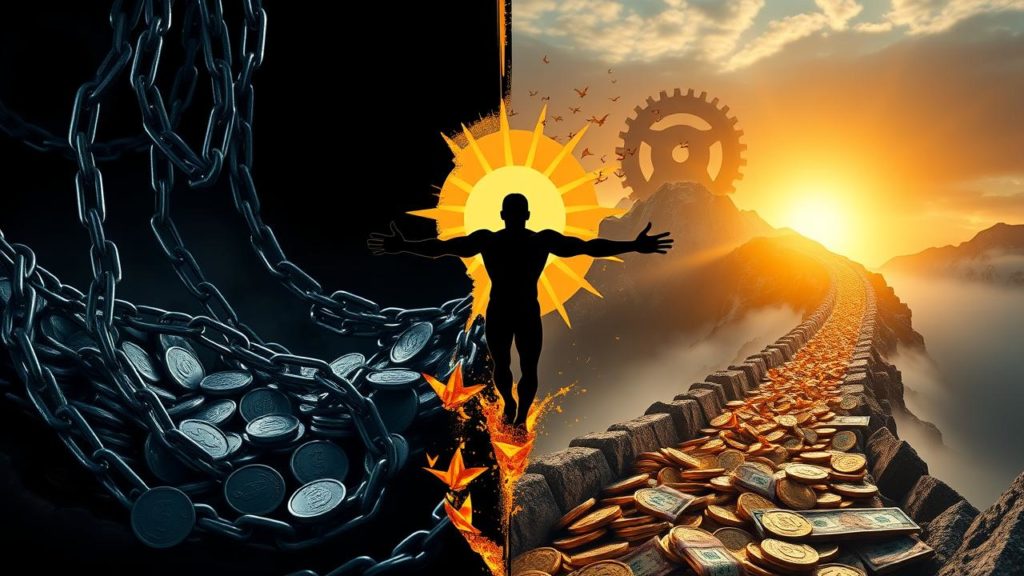A Life Where Money Doesn’t Own You
The fluorescent lights hum a low, monotonous dirge. The air tastes of stale coffee and quiet desperation. You feel it in your bones—a deep, cellular exhaustion that has nothing to do with sleep and everything to do with selling your hours, your minutes, your very lifeblood, for a number on a screen that never seems quite big enough.
This isn’t just about hating your job. It’s about the suffocating lack of choice. The golden handcuffs that feel more like cold iron shackles. The silent dread that coils in your stomach when you think about doing this for another thirty years.
But there exists a parallel reality, one that is not born of lottery tickets or inherited fortunes. It is forged in discipline, fortified by knowledge, and powered by a furious, unyielding desire to be free. This is the world of financial independence. It’s the point where your assets generate enough income to cover your living expenses, forever. It’s the moment work becomes a choice, not a sentence.
The Escape Route
This isn’t another hollow promise. This is a map. We will not just define the territory of financial freedom; we will explore its darkest corners and its most brilliant peaks. You will see the grit behind the glory, the numbers behind the narrative, and the profound mindset shift required to turn the key and walk out of the prison of obligation.
You’ll learn what financial independence truly means, how it differs from just quitting your job early, and the raw mechanics of calculating your own freedom number. We will walk through the victories, and more importantly, the stumbles of those who have walked this path before you. This is your blueprint.
What It Means to Finally Breathe
The stale air of the warehouse clung to him, a cocktail of cardboard dust and diesel fumes from the loading bay. He could feel the vibration of the forklifts through the soles of his worn-out safety boots, a constant tremor that mirrored the anxiety thrumming just beneath his ribs. For eight hours a day, he was a ghost in the machine of global commerce, a human node in a system that would replace him without a second thought.
At home, scrolling through his phone in the blessed quiet, Amari stumbled upon a thread. It wasn’t about getting rich quick or some crypto scam. It was about something else. Something that felt solid. The phrase lodged in his brain, rattling around the empty spaces where his own dreams used to be: what is financial independence? It wasn’t about yachts and mansions. It was simpler, and far more revolutionary. It was about owning your time. Having enough money working for you—through investments, through assets—that you no longer had to trade your life for it.
Financial independence is the state of having sufficient income to pay one’s living expenses for the rest of one’s life without having to be employed or dependent on others. It’s the ultimate decoupling. The moment the umbilical cord to a mandatory paycheck is finally, gloriously severed. For Amari, staring at the cracked ceiling of his apartment, it was the first time in years he felt the earth shift beneath his feet, not from a passing truck, but from a surge of possibility.
Freedom vs. An Empty Calendar
The distinction is subtle, but it’s the difference between a destination and a journey. Early retirement is an event—a finish line where you trade your desk for a beach chair. So many fixate on that one single day. They dream of an endless Saturday, only to find that a life without purpose can become its own kind of prison, just with better scenery.
True financial freedom is something else entirely. It’s a state of being. The core of financial independence vs early retirement is about having options, not obligations. It’s the power to say “no” to a project that kills your soul, or “yes” to a passion that pays nothing. It’s the ability to downshift your career, start a business without the terror of impending bankruptcy, or dedicate your life to a cause you believe in. Retirement might be one of those options, but it’s not the only one. Freedom is the goal; retirement is just one possible way to spend it.
The Tribe of the Timeline Rebels: The FIRE Movement
Somewhere in the digital ether, a quiet rebellion took root. It blossomed on forums and blogs, whispered between cubicles by those who saw the traditional path—work for 40 years, save a little, retire at 67, and hope you’re healthy enough to enjoy it—as a colossal bait-and-switch.
This is the essence of the FIRE movement explained. FIRE stands for Financial Independence, Retire Early. It’s a lifestyle movement defined by aggressive saving, extreme frugality, and diligent investing. Proponents often aim to save 50% or more of their income, funneling it into low-cost index funds and other investments, with the goal of reaching financial independence in a fraction of the time. It’s a hardcore philosophy, a mathematical and psychological assault on the status quo. It’s for people who looked at the standard timeline of life and decided to draw their own.
Mapping the Terrain of Your Ascent
Understanding where you are is the first step to getting where you want to go. The path to financial independence isn’t a single leap; it’s a series of distinct stages, each with its own challenges and psychology. This video brilliantly breaks down the seven levels of financial independence, turning a huge, abstract goal into a tangible, step-by-step climb. It provides a clear visual for your own progress.
Source: Erin Talks Money on YouTube
Your Freedom Number: More Than Just Math
Forget budgets for a moment. Forget spreadsheets filled with guilt and restriction. Think of this number as a key. A very specific key, cut to the precise shape of the life you want to live. Figuring out how to calculate your financial independence number is the process of defining the cost of your freedom.
The most common method is the “25x Rule,” derived from the 4% safe withdrawal rate. You calculate your projected annual expenses in retirement and multiply that figure by 25. For example, if you believe you can live comfortably on $40,000 per year, your FI number is $1,000,000 ($40,000 x 25). That million-dollar nest egg, invested wisely, should allow you to withdraw 4% each year ($40,000) with a very high probability of never running out of money. This isn’t just a number; it is your North Star. It transforms a vague wish into a concrete, measurable target.
The Reality Simulation Engine
A number is one thing. Watching it change, bend, and react to your decisions is another. This is the power of a good financial independence calculator. It’s not a static tool; it’s a dynamic simulator for your future. You can plug in your savings rate, your investment returns, your planned expenses, and see your timeline to freedom stretch or shrink in real-time.
It can feel like a game, but the stakes are your life. What happens if you save an extra $200 a month? How does a slightly more aggressive investment strategy change your FI date? These tools take the abstract concept and make it visceral. They turn a far-off dream into a series of levers you can pull right now. Some of the most robust investment calculators/tools can even factor in inflation and market volatility, giving you a brutally honest look at your trajectory.
The Ascent: Handholds on the Cliff Face
At 5 a.m., the only light in the kitchen came from the glow of the coffee maker. Victor’s hands, calloused and mapped with the fine scars of his trade as a journeyman electrician, wrapped around the warm mug. Every day was a battle. Not just against the physical demands of the job, but against the insidious whisper that this was all there was. But Victor had found the map. He was on the path, and each step was a deliberate act of defiance.
The steps to achieve financial independence aren’t secrets whispered in a billionaire’s club. They are simple, brutal, and effective. They are the handholds you use to pull yourself up.
- Obliterate High-Interest Debt: You cannot out-invest a 22% credit card interest rate. It’s like trying to fill a bucket with a hole in the bottom. This is your first war. Win it decisively.
- Build a Moat (Your Emergency Fund): Life throws punches. A 3-6 month emergency fund is your shock absorber. It’s what lets you handle a job loss or a blown transmission without derailing your entire future.
- Know Your Numbers, Own Your Future: Track your spending. Not to shame yourself, but to understand where your money, your life force, is actually going. This is the data you need to optimize your savings rate.
- Maximize Your Savings Rate: This is the engine of your progress. It’s a simple equation: the bigger the gap between what you earn and what you spend, the faster you reach the goal. This might mean earning more, spending less, or—ideally—a powerful combination of both.
- Deploy Your Capital: Your savings need to work for you. This means investing. For most people, this involves low-cost, diversified index funds in tax-advantaged retirement accounts like a 401(k) or IRA. It’s not about picking stocks; it’s about buying the whole market and letting the power of compounding do the heavy lifting. The sooner you start, the more powerful this force becomes.
- Automate Everything: Automate your savings. Automate your investments. Willpower is a finite resource. Build a system that makes progress the default setting, a system that works even when you’re tired, discouraged, or distracted. This is the heart of effective investment planning.
- Optimize and Escalate: As you earn more, fight lifestyle inflation. As you learn more, you can explore more sophisticated strategies in the realm of advanced investing and wealth building, but a simple, automated plan executed consistently will beat a complex plan you never start.
The Battlefield Inside Your Head
The spreadsheet on her dual monitors glowed with impeccable order. As a geoscientist for a major energy firm, Laurel was a master of data and logic. Her income was substantial, her savings rate was impressive, and by every metric, she was rocketing toward her FI number. Yet, every night, she lay awake, caught in a gut-wrenching loop of fear. What if the market crashed? What if she lost her job? What if a medical emergency wiped out her progress? Her financial house was made of brick, but in her mind, it was a flimsy shack in a hurricane zone.
The greatest obstacle on this journey is rarely the math. It’s the tangled, thorny wiring of your own mind. It’s the scarcity mindset that whispers you’ll never have enough, even when the numbers prove otherwise. It’s the fear of risk that keeps your money languishing in low-yield savings accounts, eaten alive by inflation. You can have the perfect plan, but if your internal architect is a saboteur, the entire structure will collapse.
Cultivating an abundance mindset isn’t about chanting affirmations in the mirror. It’s about methodically rewiring your relationship with risk, uncertainty, and money itself. It’s understanding that money is a tool, not a measure of your worth. It’s reframing frugality not as deprivation, but as an act of profound self-respect—choosing to fund your future freedom over a fleeting present comfort.
Building Your Freedom Machines
Every dollar you earn by trading your time has a ceiling. There are only so many hours in a day. To truly break free, you need to own systems that generate money independent of your direct effort. This is the holy grail of financial freedom: passive income for financial independence. And no, it’s not a myth, but it’s also not a magic button.
Think of it as building machines. Each one requires an upfront investment of time, knowledge, or capital. But once built, they run on their own, trickling cash into your accounts while you sleep, travel, or work on building the next one. These machines can take many forms:
- Investment Portfolios: The classic. A well-diversified portfolio of stocks and bonds generating dividends and capital gains. This includes strategies like dividend investing or systematic withdrawals from growth-oriented mutual funds.
- Real Estate: Owning rental properties where tenants’ payments cover your mortgage and expenses, leaving you with cash flow and an appreciating asset. real estate investing is a powerful, albeit hands-on, machine.
- Digital Assets: Creating an ebook, an online course, a popular blog with ad revenue, or a YouTube channel. The work is done upfront, but the asset can generate income for years.
- Business Systems: Building a business that can run without your daily presence, managed by systems and employees.
The key is transforming yourself from the one turning the crank to the one who owns the machine.
A Dose of Unfiltered Reality
Sometimes you don’t need another tip or trick. You need a raw, honest conversation from someone who has navigated the psychological minefield of building wealth. This isn’t about perfection; it’s about the gritty truth of the journey, the mental resilience required, and the core principles that matter more than any complex investment strategy. Prepare for a dose of straight talk.
Source: Gabe Bult on YouTube
Where the Pilgrims Stumble
Laurel’s internal torment finally came to a head on a Tuesday. After calculating that brewing her own espresso instead of buying it would save her $1,200 a year, moving her FI date up by a whole three weeks, she felt not a surge of pride, but a wave of profound emptiness. She was sacrificing every small joy at the altar of efficiency. The path had become a punishment. Her laser-focus on the finish line was burning out her will to run the race.
This is one of the most common mistakes on the path to financial independence. This journey is a marathon, not a sprint, and these are the ditches many fall into:
- The Cult of Deprivation: Mistaking vicious self-denial for smart frugality. You have to live a life you actually enjoy along the way, or you’ll burn out and abandon the quest entirely.
- Analysis Paralysis: Being so terrified of making a suboptimal wealth management decision that you make none at all. Waiting for the “perfect” investment while your cash is devoured by inflation is a losing strategy.
- Ignoring the “Earn More” Lever: Frugality can only take you so far. There’s a mathematical limit to how much you can cut, but there is theoretically no limit to how much you can earn. Neglecting skills and income growth is a critical error.
- Going It Alone: Trying to navigate this complex journey in a vacuum. The isolation can amplify fear and doubt. Finding a community, even an online one, provides perspective and resilience.
Laurel didn’t quit. Instead, she ‘budgeted’ for the espresso. She realized that sustainable progress required fuel, and sometimes that fuel tastes like overpriced coffee. The path wasn’t just about the destination; it was about building a life worth living as she walked it.
Starting the Game on ‘Easy Mode’
How does it feel to stand at the base of a mountain with nothing in your pockets but decades of time? Terrifying. And unbelievably powerful.
The conversation around financial independence for young adults often misses the single greatest asset they possess: a vast and forgiving timeline. The magic of compound interest is a force of nature, and the earlier you unleash it, the more earth-shattering its effects. A dollar invested at 20 is exponentially more powerful than a dollar invested at 40.
The goal isn’t to have it all figured out by 22. It’s to build the habits. Learn to live on less than you make. Get that first $1,000 invested, even if it feels laughably small. Open a Roth IRA. Read a book. Start. Because the foundation you lay in your youth, brick by painful, unglamorous brick, will become the unshakeable skyscraper of your future freedom.
Your Arsenal of Knowledge
You can’t win a war without intelligence. The best books on financial independence are more than just guides; they are weapon manuals, philosophical treatises, and raw, honest accounts from the front lines. They arm you with the strategies and mindset to succeed.
“The Simple Path to Wealth” by JL Collins: Less a book, more a series of letters from a wise, no-nonsense father. It cuts through the jargon and delivers a simple, powerful, and overwhelmingly effective strategy for building wealth through low-cost index funds. A must-read.
“Your Money or Your Life” by Vicki Robin and Joe Dominguez: The philosophical bedrock of the modern FI movement. It forces you to re-evaluate your relationship with money by calculating the “life energy” you trade for every dollar you earn and spend. It’s a gut-punch of clarity.
“The Millionaire Next Door” by Thomas J. Stanley and William D. Danko: A myth-busting masterpiece. This book reveals that most of America’s millionaires live quiet, frugal lives, a stark contrast to the high-consumption lifestyles we’re taught to admire. It’s a powerful lesson in stealth wealth.
Your Digital Command Center
You are the general of your own financial army. These tools are your command center, giving you the real-time data you need to make strategic decisions.
- Net Worth Trackers (like Personal Capital/Empower or Mint): These platforms aggregate all your accounts—banking, investments, loans—into a single dashboard. Seeing your net worth trend up (or down) provides powerful, motivating feedback on your strategy.
- Budgeting Apps (like YNAB – You Need A Budget): For those who need a hands-on approach, YNAB is a powerful tool built on a “give every dollar a job” philosophy. It’s less about restriction and more about intentionality.
- Investment Platforms (like Vanguard, Fidelity, or Charles Schwab): These are the institutions where you can buy the low-cost index funds and ETFs that will form the backbone of your wealth-building engine. Choose one with low fees and a user-friendly interface.
Dispatches from the No-Man’s-Land of Doubt
What is the 4% rule, really?
The 4% rule is a guideline, not an ironclad law of physics. Based on historical market data, it suggests that you can withdraw 4% of your initial retirement portfolio value in your first year of retirement, and then adjust that amount for inflation each subsequent year, with a high probability of your money lasting for at least 30 years. It’s a solid starting point for planning, but it’s wise to stress-test your plan against lower withdrawal rates (like 3.5%) for extra security, especially for a very early or long retirement.
But what if the market crashes right after I retire?
This is called “sequence of returns risk,” and it’s a legitimate fear. A major downturn in the early years of retirement can severely damage a portfolio. This is why having a buffer is crucial. Many early retirees keep 1-3 years of living expenses in cash or bonds. This allows them to live off their cash reserves during a downturn instead of selling their stocks at rock-bottom prices, giving their portfolio time to recover. The path to financial independence requires planning for storms, not just sunny days.
Does achieving financial independence mean I have to be a hermit who eats rice and beans?
Only if you want to. While a high savings rate is non-negotiable, the journey is one of optimization, not just deprivation. It’s about ruthlessly cutting costs on things you don’t care about (like a new car every three years) so you can spend lavishly on things you do (like international travel or a hobby that lights you up). It’s about conscious, intentional spending, not mindless, miserable austerity.
Continue the Reconnaissance
The journey is long, and the terrain changes. These resources provide ongoing intel, community support, and deeper dives into the strategies that build lasting freedom.
- r/financialindependence: The digital town square for the FIRE movement. A massive community sharing wins, struggles, and strategies.
- Investopedia on FIRE: A solid, academic breakdown of the core concepts of the movement.
- The Simple Path to Wealth: The foundational book mentioned earlier. If you read one book, make it this one.
- Better Money Habits Guide: A straightforward, step-by-step guide from Bank of America that covers the basics well.
- The White Coat Investor: While aimed at high-income professionals like doctors, the financial principles are universal and explained with incredible clarity.
The First Step Out of the Cell
Freedom isn’t a gift. It isn’t granted. It is seized. The journey to financial independence doesn’t begin when you have thousands to invest; it begins with a single, furious decision to stop trading your life away cheaply. It begins with the choice to reclaim one dollar. To automate one savings transfer. To read one chapter of one book.
You have the map now. The terrain is treacherous, and the climb is steep. Your own mind will be your greatest adversary. But the peak is real. The air up there is clean and clear, and the view is of a life that is truly, finally, your own.
Take one step. Now.







